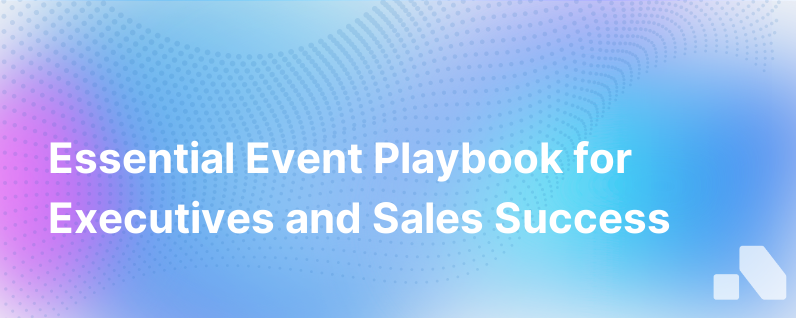Event Playbook
Published on December 27, 2023 by Sawyer Middeleer
In the B2B space, events play a monumental role in networking, branding, and lead generation. They come in many forms: conferences, webinars, trade shows, and round-table discussions, each offering unique advantages in creating touchpoints with customers, prospects, and influencers.
However, success at these events doesn't come from merely showing up and setting up a booth. It requires a strategic approach before, during, and after the event. That's where an event playbook comes into focus. This strategic document serves as a comprehensive guide to optimize every aspect of event participation for maximum impact.
Let's explore the anatomy of a strong event playbook and how crafting one can equip your teams with the tactics and strategies necessary to turn a standard industry event into a substantial opportunity for growth.
A. Pre-Event Planning
Defining Objectives
Clearly defined goals are the foundation of any successful event strategy. What does your company aim to achieve through its participation? Is it about lead generation, customer engagement, thought leadership, market research, launching a new product, or perhaps a mix of these? Setting SMART (Specific, Measurable, Achievable, Relevant, Time-bound) objectives will create a benchmark against which you can measure post-event performance.
Audience Insights
Understanding who will be attending the event and what they're looking for is key to tailoring your playbook strategies. Are they C-level executives, managers, or technical experts? Are they seeking education, networking, or solutions to specific challenges? Gathering these insights will help shape everything from the messaging to the choice of personnel you deploy.
Budget Allocation
Events can get expensive. Allocating your budget to cover essentials and extras such as booth design, sponsorship packages, travel, and accommodations, marketing materials, and lead capture technology requires careful planning. ROI estimation plays a crucial role in this stage to justify the investment.
Messaging and Materials
Your brand messaging must resonate with the event theme and audience. It's about creating a consistent narrative across all materials, from booth banners to digital ads, press releases, and the promo items you hand out. Sales and marketing collateral must be aligned to articulate the value proposition succinctly.
Booth Design and Experience
Your booth is your event headquarters. The design should stand out and encapsulate your brand identity. Consideration must also be given to the attendee journey around and through your space, optimizing for flow and engagement. Interactive displays and demos can be strong draws.
Team Preparation
Team members representing your brand at the event should be well-versed in product knowledge, company messaging, and the playbook objectives. Potential scenarios and FAQs should be role-played to ensure confidence and to provide a consistent experience to every visitor.
Meetings and Networking
Advance scheduling of meetings with prospects, customers, partners, and influencers can ensure that your team makes the most of every networking opportunity. Social events affording casual networking should not be undervalued and should have a clear strategy tied to them.
B. During the Event
Engaging Execution
From delivering a killer pitch to handling inquiries and objections on the fly, having well-prepared and enthusiastic team members is vital. They should encapsulate the goals outlined in the playbook and pivot as necessary depending on the audience in front of them.
Lead Capture
This is a time to convert interest into potential sales and long-term relationships. Whether through traditional business cards or digital scanners, a process must be in place for effective and immediate lead capture, which feeds directly into the CRM and follow-up processes.
Social Media
Leverage live-tweeting, LinkedIn updates, live videos, and Instagram stories to boost event visibility and engagement. Social media should be utilized to share insights, broadcast key moments, and foster connections, both at the event and with those following remotely.
C. Post-Event Activities
Prompt Follow-Up
Don't let leads grow cold. Immediate follow-ups with personalized messages can keep the momentum going. Use the insights gathered during conversations to tailor your communication and make it relevant to each individual lead.
Analysis and Reporting
Measure performance against the initial objectives. Break down the success metrics—leads generated, meetings conducted, impressions made, deals closed, or others as previously defined. This will help to refine future playbooks.
Internal Knowledge Sharing
Post-event debriefs are pivotal for sharing insights, successes, challenges, and the feedback gained from attendees and competitors. This shared knowledge can influence product development, marketing strategies, and future event participation.
Content Leverage
Repurpose content gathered from the event into blog posts, case studies, whitepapers, and social media content. Demonstrating your active participation in industry conversations is content marketing gold.
D. Continuous Improvement
Review and Refine
Each event should be a learning experience. Assess what worked, what didn’t, and which unexpected factors arose. This is where you refine your playbook for the next round, constantly evolving your strategies for improvement.
Conclusion
By treating each event as a strategic project—with its own goals, tactics, and metrics—a well-crafted event playbook can secure a significant competitive edge. It is the difference between a haphazard presence at industry events and managing a productive, ROI-driven campaign that aligns with your overarching business goals. Beyond the execution of the playbook, a comprehensive view of each event's efficacy allows for iterative improvement, turning every occasion into an opportunity to enhance the playbook's effectiveness even further.